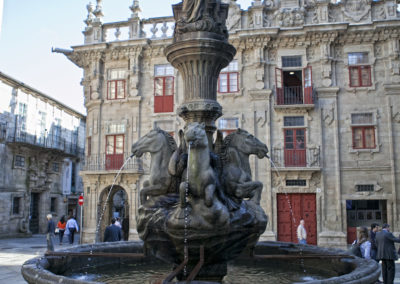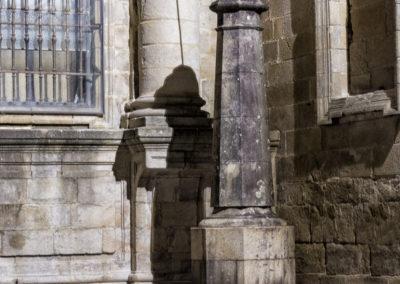THE FOUR SEATS
We start from the Plaza del Obradoiro, pedestrianized since the 80s, for many one of the most beautiful in the world. It is the place of arrival of pilgrims and an essential visit for millions of tourists, which adds to the constant passage of students who access the Faculty of Medicine and the North University Campus from the old town.
It is presided over by the imposing baroque façade of the Obradoiro, built to close the old Romanesque door or Portico of Glory by Maestro Mateo. On the right we will see the long balcony of the Claustral Building, which is on the corner in the square in front of the College of San Xerome, just where one of the two turrets that crowns it, first the tower of La Vela or the Crown, 1615 -In her day used as a prison- and, already on the corner with the Platerías Square, that of the Treasury.
PLATERÍAS
Following the high and smooth walls of the Claustral Building we enter Platerías. To our right is the curious and baroque Casa do Cabido, the entrance to Rúa del Villar, and the only building that after many centuries has disfigured this environment, that of the Bank of Spain, now the Museum of Pilgrimage. The center of the Plaza is occupied by the Platerías Fountain, from 1829. In the past, the square was closed with chains and artisans were concentrated there, selling silver objects, corals and precious stones in establishments that in fact can still be seen under the cloister building.
If we climb the stairs (18th century) looking up we will see the Clock Tower, also known as La Berenguela after the archbishop who finished it in 1320, although it later underwent several renovations. The current clock was made in Ferrol in 1831; and the bell, in 1729. We are now in front of the Platerías façade, the oldest and artistically the most important of the Cathedral. Its construction began in 1103 and later it was collecting loose elements from other areas of the Cathedral, which were moved during the renovations. Several scenes from the life of Jesus Christ are represented in the reliefs; and contains some of the most famous images of the Cathedral of Santiago, such as that of the adulterous woman or David.
In Platerías, artisans were concentrated, selling silver objects, corals and precious stones in establishments that can still be seen.
Turning the corner, the old cemetery (quintana) appears before our eyes, the large stone esplanade in front of which the Holy Door opens. It is the Plaza de la Quintana popularly divided into Quintana de Abaixo or the dead, and Arriba or the living. At the end of this façade is where the Canonical Gate formerly existed, according to the Calixtinus Codex, through which the canons entered from their house in this square. Currently, only the Holy Door remains, which is opened to pilgrims in holy years.
This square has witnessed many student demonstrations. Also children’s games. And, in the late 70s and 80s, it was a popular place for students, who used the grand staircase to sit, read, chat or play the guitar in groups.
La Quintana is a busy square, witness to demonstrations, moments of leisure and children’s games.
AZABACHERÍA
A small alley bordering the Cathedral takes us to the Plaza de la Azabachería, former Rúa Francígena, where the great hospital and pilgrim hostel founded by Diego Xelmírez was located, which preceded the one built later under the patronage of the Catholic Monarchs. Its name is due to the fact that it was there where the powerful workshops of the azabacheros began and developed, who since the 12th century produced thousands of pieces for the pilgrims to take with them on their return, such as figures of Santiago, shells or figas. In the square the two great religious powers of the city confront each other and seem to maintain a pulse: the Cathedral and San Martiño Pinario. Here were, according to the Codex Calixtinus, the Gate and Fountain of Paradise.
The old façade was very similar to that of Platerías. Due to its ruinous state, the current one was demolished and built, based on the baroque project of Lucas Ferro Caveiro and with a finish already in neoclassicism. Medieval craftsmen, money changers and jewelers were located in the paved square, selling products related to pilgrims. Looking straight at the façade on the left, the exterior Romanesque structure of the Corticela is preserved, an independent parish that was completely incorporated into the Cathedral with the expansion.
Through the Arch of the Archbishop’s Palace we return to the starting point, the Plaza del Obradoiro.
Download the route on Wikiloc (coming soon)



